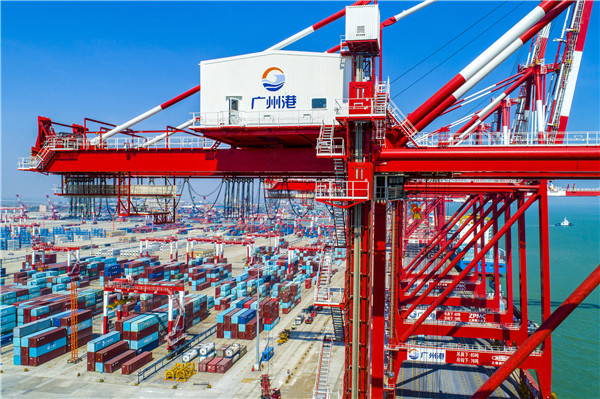New blueprint takes aim at local enterprises

The Guangzhou Port is one of four major hub ports in China to operate the automobile import and export. CHINA DAILY
With the support of local authorities and help of beneficial policies, enterprises are set to enjoy boundless opportunities in Nansha, Guangzhou, business insiders said.
Nansha district is located at the geometric center of the Guangdong-Hong Kong-Macao Greater Bay Area. Its shipping routes cover 14 large and medium-sized cities such as Foshan, Dongguan, Zhongshan, Jiangmen and other cities in the western region of the Pearl River Delta area.
In recent years, Nansha has focused on building a high-quality development model driven by innovation, especially in the fields of commercial system reform, financial management and land utilization, said Dong Lei, deputy manager of Guangzhou Nansha International Cold Chain.
Enjoying the multilayer policy advantages as a national-level new area, bonded port area, free-trade pilot zone and comprehensive bonded zone, Nansha's business environment ranks at the top of other national-level new areas, laying a solid foundation for high-quality development, Dong said.
Nansha Harbor, located in the Nansha New Area, is one of the main parts of Guangzhou Port. It is one of the few terminals that can berth the world-level large container ships.
Guangzhou Port Group operates the largest part of the business in Guangzhou Port, which is playing a significant role as a transportation hub connecting different ports, railway transitions and high-speed road networks in the Pearl River Delta region.
Its main businesses cover the handling and transporting of containers, petrochemicals, coal, steel, grain, automobile and other goods, as well as warehousing, domestic and foreign cargo proxy service and waterway cargo transportation and logistics services.
In 2020, the cargo throughput of Guangzhou Port ranked fourth in the world. The throughput of the container in the port ranks among the top in the world.
Guangzhou Port is one of the four major hub ports in China to operate the automobile import and export business and also the largest port to transport energy and grain in South China.
Top Ideal Group's Guangdong, Hong Kong and Macao International Supply Chain is operating its digital service trade platform in Nansha. The platform is a model and regulatory innovation project incubated in Nansha and one of the world's first digital cross-border industry platforms.
Its President Yu Chonggang said since the beginning of the third decade of this century, many excellent enterprises have started to build internet targeting businesses focusing on connecting the core resources in manufacturing and supply chains.
However, many people have ignored the foreign trade service industry, Yu said. He added that several major obstacles are hampering the foreign trade service industry.
"First, we lack the power of discourse and bargaining," he said. "Second, our service capability is far from adequate."
"We're able to buy and sell products around the globe, but it is still a stretch to say every enterprise has the ability to serve the world. If the service capacity of the foreign trade industry is not enough, it will affect the discoursing process in trade negotiations," Yu said.
In Yu's view, the third obstacle in the foreign trade service industry is the insufficiency to make proper use of digital tools.
Therefore, a digital service trade platform for better distribution of high-quality products is an innovative model built for the digital age.
By aggregating the service resources, the model is conducive to forming local industrial competitiveness so that all enterprises can participate in international competition and build up the power of the discourse, while enhancing their position in the international value chain.
"Leveraging the power of business models, we cooperate with the government and industry to boost capacity, national strength and international competitiveness in the foreign trade industry. This is what we are pursuing," Yu said.



 Print
Print Mail
Mail

